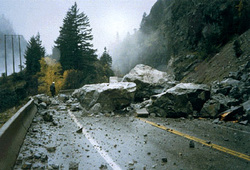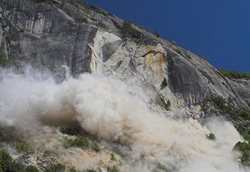Mass Movement
The transfer of rock and soil downslope due to gravity is called mass movement. Some types of mass movement are so slow that you cannot see them. Landslides on the other hand, can happen very suddenly. Weathering and mass movement together produce landforms. Weathering breaks apart the rock and mass movement carries the debris downslope.
Five basic types of mass movement are rockfall, slides, slumps, flows and creep. Alll these types of mass movement may be caused by water, oversteepened slopes, removal of vegetation, and earthquakes.
A rockfall is when rock fragments fall freely through the air. It's common on slopes that are too steep for the loose material to remain on the surface. Slides such as rockslides occur when a block of material moves suddenly along a flat, inclined surface. They happen oftenly in mountainous areas. Rockslides are among the fastest mass movements, sometimes reaching up to 200 kmph. Rockslides can be triggered by rain or melting snow.
A slump is the downward movement of a block of material along a curved surface. Material involved in a slump usually does not travel very fast or very far. When the block of material moves, it's upper surface sometimes tilts backwards, causing a crescent-shaped cliff above the slump. They are common on oversteepened slopes where the soil contains thick accumulations of clay.
Flows are mass movements containing large amounts of water, which move downslope in a thick fluid. Flows that move quickly are called mudflows and are common in semiarid mountainous regions. An Earthflow is another type of flow, but they move considerably slower than mudflows. An Earthflows movement can continue for years
Creep is the slowest type of mass movement. Creep only travels the distance of a few centimeters a year. The alternating between freezing and thawing contribute to creep. Because creep is so slow, you can't directly observe it, but the effects of creep are very recognizable.
Five basic types of mass movement are rockfall, slides, slumps, flows and creep. Alll these types of mass movement may be caused by water, oversteepened slopes, removal of vegetation, and earthquakes.
A rockfall is when rock fragments fall freely through the air. It's common on slopes that are too steep for the loose material to remain on the surface. Slides such as rockslides occur when a block of material moves suddenly along a flat, inclined surface. They happen oftenly in mountainous areas. Rockslides are among the fastest mass movements, sometimes reaching up to 200 kmph. Rockslides can be triggered by rain or melting snow.
A slump is the downward movement of a block of material along a curved surface. Material involved in a slump usually does not travel very fast or very far. When the block of material moves, it's upper surface sometimes tilts backwards, causing a crescent-shaped cliff above the slump. They are common on oversteepened slopes where the soil contains thick accumulations of clay.
Flows are mass movements containing large amounts of water, which move downslope in a thick fluid. Flows that move quickly are called mudflows and are common in semiarid mountainous regions. An Earthflow is another type of flow, but they move considerably slower than mudflows. An Earthflows movement can continue for years
Creep is the slowest type of mass movement. Creep only travels the distance of a few centimeters a year. The alternating between freezing and thawing contribute to creep. Because creep is so slow, you can't directly observe it, but the effects of creep are very recognizable.


